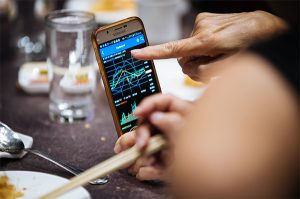Date: December 6, 2021

- A volatile week ended with the STI down 65 points or 2% at 3,101.02
- Emergence of new Omicron virus variant was main culprit
- Banks were main index drivers
- Average daily turnover doubled to S$2b, almost S$4b was done on Tue
- October’s retail sales grew a better-than-expected 7.5% y-o-y
- Wall St took Omicron hit and wobbled after US Fed chief Powell said inflation is not “transitory’’
- US Treasury yields narrow on tapering, interest rate concerns
A volatile week for global markets
The local stock market, along with Wall Street and most other global markets, underwent a volatile and ultimate soft week after the emergence of the Omicron variant of the Covid-19 virus.
Worried that this new variant could be more contagious and possibly more dangerous than previous variants like the Delta, investors sold out of risky assets and moved into safe havens such as US Treasuries.
Over on Wall Street, the selling was also aggravated by mid-week comments from US Federal Reserve chairman Jerome Powell that recently high inflation may last longer than many think and that the central bank may soon increase the speed at which it is ending its bond-buying program.
The STI lost 65 points or 2%, volume shot up
Overall, it made for a volatile five days for the Straits Times Index, which on Tuesday dived below the 3,100 level when it lost 79 points or 2.5% at 3,041.29. Much of daily trading was driven by traders keeping an eye on the Dow futures to try and figure out how Wall St would trade later each day; on Thursday the STI managed to fleetingly regain 3,100 before ending at 3,092.
On Friday, the index managed to rise 9.82 points to 3,101.93, thereby cutting its loss for the week to 65 points or about 2%. Volume ballooned to an average of S$2b per day, much more than the anaemic S$1b averages of the previous weeks.
The highest business was done on Tuesday, when the STI plunged almost 80 points and S$3.89b were traded. The week’s lowest haul came on Friday, when S$1.13b changed hands.
Still, as has been mentioned before in this report, gains in the index were not necessarily reflected in the broader market. On Wednesday for instance, when the STI jumped almost 57 points or 2%, there were 230 rises versus 237 falls in the entire market.
Banks were the main drivers of the index – and dollar volume
Most of the index’s movements were dictated by the three banks, with DBS leading the way. On Monday and Tuesday DBS lost S$1.70 at S$29.87, before rebounding S$1.51 on Wednesday. The bulk of daily dollar turnover could be traced to trading in DBS, UOB and OCBC, with significant contributions from Singtel, CapitaLand Investments and Singapore Airlines.
Better-than-expected retail sales
Retail sales in Singapore saw better-than-expected growth in October despite tighter Covid-19 restrictions, partly due to higher mobile phone sales from new product launches.
Takings at the till rose 7.5 per cent year on year, extending the revised 6.8 per cent increase in September, according to data released by the Singapore Department of Statistics on Friday (Dec 3).
October’s uptick in retail sales was stronger than the 4.4 per cent growth tipped by economists in a Bloomberg poll
US inflation is no longer “transitory’
Federal Reserve Chairman Jerome Powell last week said he expects policymakers in December to discuss accelerating the timetable for the tapering of monthly bond purchases.
Speaking before a Senate panel, he said tapering could wrap up “a few months sooner” than anticipated. That would open the door to interest rate hikes thereafter. Powell also said “it’s probably a good time to retire” the word “transitory” to describe inflation.
The S&P 500 index over the week lost 1.2%, while the Dow Jones Industrial Average fell 319.26 points, or 0.9%, and the Nasdaq Composite slumped 2.6%.
The S&P 500 finished the week 3.5% off its 2021 high, which is a bit less than the index fell in September, when everyone was predicting a correction that never arrived.
Gap between US Treasury yields narrowed
Bets that the Fed could hike short-term interest rates several times within the next year have been on the rise. The 1-year Treasury yield rose to 0.26% Wednesday from 0.14% earlier in the week. That helped send the 1- year Treasury yield down to 1.42%, as Fed rate hikes would choke off economic demand and inflation for the longer-term.
In fact, the difference in yield between the 10 year and 2-year Treasury yields reached its slimmest level since January 5 this year. That was before markets began reflecting re-inflation and the surge in economic demand.






